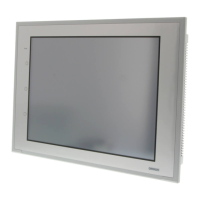Section 1 Overview 1-3 Communicating with the Host
1-21
NS Series Programming Manual
1-3-4 NT Links
The NT Link protocol was specially designed to enable high-speed communications with OMRON
PLCs.
The following PLCs can be connected using NT Links.
CPM1A, CPM2A, CPM2C, CQM1, CQM1H, C200HS, C200HX/HG/HE-E/-ZE, CS1G/CS1H-E(V1),
CS1G/CS1H-H, CVM1/CV (V1 or later), CJ1G, CJ1G-H/ CJ1H-H, CJ1M, CP1H, and CP1L
In addition to the 1:1 NT Links, where one PT serial port is connected to one PLC, NS-series PTs can
also use the 1:N NT Links, where up to eight PTs are connected to one PLC.
The following PLCs can be connected using a 1:N NT Links.
CQM1H, C200HX/HG/HE-E/-ZE, CS1G/CS1H-E(V1), CS1G/CS1H-H, CJ1G, CJ1G-H/ CJ1H-H, CJ1M,
CP1H, and CP1L.
NS-series PTs also support a high-speed 1:N NT Link that allows faster communications. The following
PLCs can be connected using a high-speed 1:N NT Links.
CS1G/CS1H (V1 or later), CS1G/CS1H-H, CJ1G, CJ1G-H/ CJ1H-H, CJ1M, CP1H, and CP1L.
In later sections, the term “NT Link” will be used when describing the NT Link communications method
in general, “1:1 NT Link” will be used when describing the 1:1 NT Link connection method only, and
“1:N NT Link” will be used when describing the 1:N NT Link connection method only. Furthermore, dif-
ferentiation will be made between standard and high-speed 1:N NT Links when required. If only “1:N
NT Link” is noted, the description will refer to both standard and high-speed 1:N NT Links.
NT Link Features
NT Links have the following features.
1. NT Links facilitate high-speed communications with PLCs. The high-speed 1:N NT Link, which
enables even faster communications, is also supported.
2. Data can be written to PLC memory areas in bit units. This allows other bits in the word to which a
touch switch has been allocated to be used for another applications, such as lamp allocations.
However, data is written in word units only in the DM and EM Areas, so other bits in the word to
which touch switches are allocated cannot be used for other applications in these memory areas.
3. NS-series PTs can be connected without switching PLC operating modes.
4. Up to eight PTs can be connected to one PLC port when 1:N NT Links are used and all ports can
be used simultaneously. Up to eight ports can be used simultaneously for high-speed 1:N NT Links
also.
Normal 1:N NT Links and high-speed 1:N NT Links cannot, however, both be used on the same
PLC port.
5. If a Communications Board is mounted in the CPU Unit option slot on a C200HX/HG/HE-E/-ZE
PLC, up to three standard 1:N NT Link systems (up to 24 PTs) can be connected. Only standard
1:N NT Link connections can be made. Refer to the C200HX/HG/HE Communications Boards Op-
eration Manual (W304-E1-@) for information on Communications Boards.
6. If a Serial Communications Board is mounted in the CPU Unit Inner Board slot on CQM1H PLCs,
up to two standard 1:N NT Link systems (up to 16 PTs) can be connected. Only standard 1:N NT
Link connections can be made. Refer to CQM1H Serial Communications Board Operation Manual
(W365-E1-@) for information on Serial Communications Boards.
7. If a Serial Communications Board is mounted to the CPU Unit Inner Board slot or a Serial Com-
munications Unit is mounted to the Backplane of a CS1G/H or CS1G/H PLC, multiple standard or
high-speed 1:N NT Link systems can be connected. Refer to CS/CJ Series Serial Communications
Boards and Unit Operation Manual (W336-E1-@) for information on Serial Communications Boards
and Serial Communications Units.
8. If the PLC supports the device monitor function, the PLC operating mode can be switched from the
PT and the present values of words can be displayed or changed.

